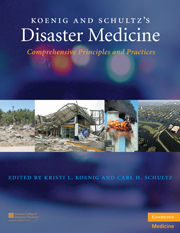Book contents
- Frontmatter
- Contents
- List of Contributors
- Contributor Biographies
- Foreword
- Preface
- Acknowledgments
- PART I CONCEPTUAL FRAMEWORK AND STRATEGIC OVERVIEW
- 1 Disaster Research and Epidemiology
- 2 Disaster Education and Training: Linking Individual and Organizational Learning and Performance
- 3 Surge Capacity
- 4 International Perspectives on Disaster Management
- 5 Ethical Issues in Disaster Medicine
- 6 Emerging Infectious Diseases: Concepts in Preparing for and Responding to the Next Microbial Threat
- 7 Disaster Mental and Behavioral Health
- 8 Special Needs Populations
- PART II OPERATIONAL ISSUES
- PART III CLINICAL MANAGEMENT
- Index
- Plate section
- References
4 - International Perspectives on Disaster Management
from PART I - CONCEPTUAL FRAMEWORK AND STRATEGIC OVERVIEW
Published online by Cambridge University Press: 05 August 2011
- Frontmatter
- Contents
- List of Contributors
- Contributor Biographies
- Foreword
- Preface
- Acknowledgments
- PART I CONCEPTUAL FRAMEWORK AND STRATEGIC OVERVIEW
- 1 Disaster Research and Epidemiology
- 2 Disaster Education and Training: Linking Individual and Organizational Learning and Performance
- 3 Surge Capacity
- 4 International Perspectives on Disaster Management
- 5 Ethical Issues in Disaster Medicine
- 6 Emerging Infectious Diseases: Concepts in Preparing for and Responding to the Next Microbial Threat
- 7 Disaster Mental and Behavioral Health
- 8 Special Needs Populations
- PART II OPERATIONAL ISSUES
- PART III CLINICAL MANAGEMENT
- Index
- Plate section
- References
Summary
OVERVIEW
For many years, disasters were perceived as unavoidable and only attributable to “natural” events. Over the last 30 years, however, professionals in the health field have begun studying the subject, realizing that there is potential to avoid the many negative consequences linked to such hazards. Public health and emergency medicine specialists were among the first groups to investigate these issues scientifically, examining ways to protect lives from the impact of disasters.
Pioneers in this new area of research included Professor Michel Lechat from the University of Louvain in Belgium, Professor Peter Safar from the University of Pittsburgh in the United States, and Professor Rudolph Frey from the University of Mainz in Germany. Professor Lechat established the Center for Research on the Epidemiology of Disasters in 1973, which subsequently became a World Health Organization (WHO) Collaborating Center for the Epidemiology of Disasters. Professors Safar and Frey founded the club of Mainz in 1976, which would become the World Association for Disaster and Emergency Medicine. Its focus was the improvement in the worldwide delivery of prehospital and emergency care during everyday events and mass casualty disasters. The disciplines of public health and emergency medicine have both made substantial contributions to the field and are now intimately linked. Subsequently, a growing number of professionals have systematically investigated disasters from a multidisciplinary and multihazard perspective.
Keywords
- Type
- Chapter
- Information
- Koenig and Schultz's Disaster MedicineComprehensive Principles and Practices, pp. 51 - 61Publisher: Cambridge University PressPrint publication year: 2009



